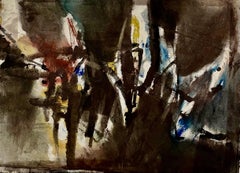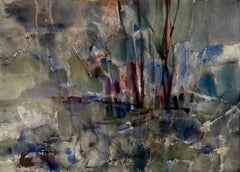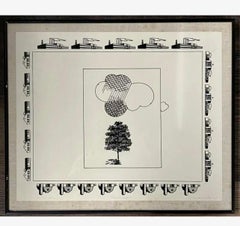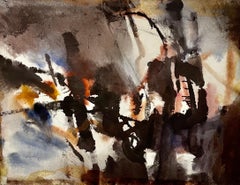Want more images or videos?
Request additional images or videos from the seller
1 of 8
Jacques YankelAbstract Expressionist Paris Landscape Painting
$1,100List Price
About the Item
- Creator:Jacques Yankel (1920, French)
- Dimensions:Height: 19.5 in (49.53 cm)Width: 17.25 in (43.82 cm)
- Medium:
- Movement & Style:
- Period:
- Condition:minor wear to frame and mat.
- Gallery Location:Surfside, FL
- Reference Number:1stDibs: LU3822608721
About the Seller
4.9
Platinum Seller
Premium sellers with a 4.7+ rating and 24-hour response times
Established in 1995
1stDibs seller since 2014
1,810 sales on 1stDibs
Typical response time: 1 hour
Authenticity Guarantee
In the unlikely event there’s an issue with an item’s authenticity, contact us within 1 year for a full refund. DetailsMoney-Back Guarantee
If your item is not as described, is damaged in transit, or does not arrive, contact us within 7 days for a full refund. Details24-Hour Cancellation
You have a 24-hour grace period in which to reconsider your purchase, with no questions asked.Vetted Professional Sellers
Our world-class sellers must adhere to strict standards for service and quality, maintaining the integrity of our listings.Price-Match Guarantee
If you find that a seller listed the same item for a lower price elsewhere, we’ll match it.Trusted Global Delivery
Our best-in-class carrier network provides specialized shipping options worldwide, including custom delivery.You May Also Like
Abstract Expressionist Outsider Art, Oil Pastel on Black Paper.
Located in Cotignac, FR
Abstract expressionist, pastel on black paper by English artist John McQuirk. Signed bottom right.
McQuirk's work is an example of outsider art or art brut.
Born in 1933, the arti...
Category
Late 20th Century Abstract Expressionist Abstract Drawings and Watercolors
Materials
Paper, Oil Pastel
$866
H 34.65 in W 26.78 in D 0.4 in
Light Buttress, by Kenneth Draper, pastel, paper, framed, abstract, England
By Kenneth Draper
Located in Santa Fe, NM
frame size 27.5" x 25.5"
Light Buttress, by Kenneth Draper, pastel, paper, framed, abstract, England
Category
21st Century and Contemporary Abstract Expressionist Abstract Drawings a...
Materials
Oil Pastel
$4,600
H 19.75 in W 18 in
Llangorse Lake Brecon Beacons Wales Circa 1964 Welsh Abstract Landscape Painting
By Roger Cecil
Located in Sutton Poyntz, Dorset
Roger Cecil.
Welsh ( b.1942 - d.2015 ).
Llangorse, Brecon Beacons.
Watercolor & Pastel Mixed Media On Paper.
Signed Lower Left.
Image size 19.5 inches x 29.5 inches ( 49.5cm x 75cm...
Category
Mid-20th Century Abstract Expressionist Landscape Drawings and Watercolors
Materials
Paper, Pastel, Watercolor
$4,818
Free Shipping
H 24.61 in W 34.65 in D 0.99 in
1999 "February" Abstract Landscape Drawing
By Elaine Kaufman Feiner
Located in Arp, TX
Elaine Kaufman Feiner (1922-2018)
"February"
1999
Oil pastel on paper
40"x30" unframed
Signed and dated in pencil lower right, signed, titled and dated on reverse
Category
1990s Abstract Abstract Drawings and Watercolors
Materials
Paper, Oil Pastel
$640 Sale Price
32% Off
H 30 in W 40 in
"Pastel Landscape in Blues 2" Original Impressionist Landscape Drawing
By Edith Isaac-Rose
Located in Arp, TX
Edith Isaac-Rose
"Pastel Landscape in Blues 2"
c.1960
Pastel on paper
17"x15" unframed
Unsigned
Edith Isaac-Rose (1929-2018)
Born in Chicago in 1929, and neé Ganansky-Teitelbaum, she graduated from The Art Institute of Chicago in 1951 and moved to New York in 1959 where she lived ever since. Taking as her professional name her parents’ first names, Edith was a prolific artist working first as an abstract expressionist then turning in the 1980s to figurative, political work consisting of drawings, paintings, and embroideries which she called “Daily Rage”.
She had been represented by the Phyllis Kind Gallery and her work is in the Hirshhorn Museum as well as numerous private collections.
Edith, along with her partner of 35 years, Bea Kreloff, (1925-2016), founded Art Workshop International in 1981 where they held art and writing workshops in Assisi, Italy, Monhegan Island, Maine, and Puerto Escondido, Mexico.
Edith was a resident at the Westbeth Artist Housing in Greenwich Village and was actively involved with the anti-war movement, gay liberation...
Category
Mid-20th Century Abstract Impressionist Landscape Drawings and Watercolors
Materials
Paper, Oil Pastel
$625
H 15 in W 0.5 in D 17 in
1988 "Hawaii II" Abstract Landscape Drawing
By Elaine Kaufman Feiner
Located in Arp, TX
Elaine Kaufman Feiner (1922-2018)
"Hawaii II"
1993
Oil pastel, paint on paper
30"x40" unframed
Signed and dated in pencil lower right, signed, titled and dated on reverse
Category
1980s Abstract Abstract Drawings and Watercolors
Materials
Paper, Oil Pastel, Paint
$617 Sale Price
35% Off
H 40 in W 30 in
The Cliff, Abstract Colorado Landscape, 1940s American Modernist Pastel Drawing
By Eric Bransby
Located in Denver, CO
This stunning artwork features an expressive blend of vibrant green, orange, blue, and purple tones, capturing the dynamic beauty of Colorado’s mountainous terrain. Created by renown...
Category
1990s Abstract Abstract Drawings and Watercolors
Materials
Oil Pastel, Pastel, Archival Paper
$3,750 Sale Price
21% Off
H 25.5 in W 32 in D 1.25 in
"Sierra Country", Abstracted Landscape Watercolor
By Erle Loran
Located in Soquel, CA
Vibrant abstract landscape watercolor titled "Sierra Country" by Erle Loran (American, 1905-1999), 1984. Titled, signed, and dated on verso. Presented in a painted metal frame, without glass. Image, 23"H x 31"L. Measures: 30"H x 37"W.
Erle Loran was a modernist of urban and coastal views and geometric painting.
Erle Loran was born in Minneapolis, Minnesota. He studied at the Minneapolis School of Art under the direction of Cameron Booth...
Category
1980s Abstract Expressionist Abstract Drawings and Watercolors
Materials
Watercolor, Archival Paper
$2,080 Sale Price
20% Off
H 30 in W 37 in D 1 in
Abstract Landscape Watercolor
By Les Anderson
Located in Soquel, CA
Abstract watercolor with loosely defined landscape elements by Les (Leslie Luverne) Anderson (American, 1928-2009). From the estate of Les Anderson in Monterey, California. Signed on...
Category
1980s Abstract Expressionist Abstract Drawings and Watercolors
Materials
Paper, Watercolor
$223 Sale Price
20% Off
H 15 in W 10 in D 0.03 in
Original drawing-Golden Summer- British Awarded Artist, custom frame included.
Located in London, GB
Shizico spent three days painting this plein air in her sunlit garden. She applied 550 Ture Gold paint and Van Gogh Yellow creating a stunning backdrop which served as the canvas for...
Category
2010s Abstract Expressionist Abstract Drawings and Watercolors
Materials
Gold
$537 Sale Price
25% Off
H 16.54 in W 11.82 in D 0.04 in
More From This Seller
View AllModernist Abstract Expressionist Watercolor Painting Bauhaus Weimar Pawel Kontny
By Pawel Kontny
Located in Surfside, FL
Abstract watercolor composition bearing the influence of the earlier color-block compositions of Paul Klee.
Pawel August Kontny, (Polish-German-American artist) He was born in Laurahuette, Poland, in 1923, the son of a wealthy pastry shop owner. In 1939 he began studying architecture in Breslau where he was introduced to the European masters and to the work of some of the German Expressionists, soon afterward banned as "degenerate artists" and removed from museums throughout Germany by the Nazi regime. His studies were interrupted by World War II. Drafted into the German army, traveling in many countries as a soldier, he sketched various landscapes but in 1945, he was captured and held as a prisoner of war in Italy. After the war, he studied at the Union of Nuremberg Architects to help design buildings to replace ones destroyed in the war. He recorded his impressions of the local population and the landscapes through his watercolors and drawings. Pawel Kontny thereafter moved to Nuremberg, Germany, becoming a member of the Union of Nuremberg Architects and helping to rebuild the city's historic center. He soon decided to concentrate on his professional art career. He married Irmgard Laurer, a dancer with the Nuremberg Opera. Pavel Kontny 's career as an artist was launched with his participation in an all German exhibition, held at the Dusseldorf Museum in 1952. He held one-man shows in Germany, Switzerland and the United States. During his trip to the United States in 1960, Kontny became instantly enamored with Colorado, and decided to relocate to Cherry Hills with his wife and two children. He quickly established himself in the local art community, being affiliated for a time with Denver Art Galleries and Saks Galleries. His subject matter became the Southwest. During this time he received the Prestigious Gold Medal of the Art Academy of Rome. His extensive travel provided material for the paintings he did using his hallmark marble dust technique. he also worked equally in pastel, watercolor, charcoal and pencil-and-ink. in a style which merged abstraction and realist styles, influenced by Abstract Expressionist painting and South Western American landscapes. This one bears the influence of Sam Francis. In the early 1960s he was one of only a few European-born professional artists in the state, a select group that included Herbert Bayer (1900-1985), a member of the prewar Bauhaus in Weimar and Dessau, Germany, and Roland Detre...
Category
20th Century American Modern Abstract Drawings and Watercolors
Materials
Watercolor, Archival Paper
Modernist Abstract Expressionist Watercolor Painting Bauhaus Weimar Pawel Kontny
By Pawel Kontny
Located in Surfside, FL
Abstract watercolor composition bearing the influence of the earlier color-block compositions of Paul Klee.
Pawel August Kontny, (Polish-German-American artist) He was born in Laurahuette, Poland, in 1923, the son of a wealthy pastry shop owner. In 1939 he began studying architecture in Breslau where he was introduced to the European masters and to the work of some of the German Expressionists, soon afterward banned as "degenerate artists" and removed from museums throughout Germany by the Nazi regime. His studies were interrupted by World War II. Drafted into the German army, traveling in many countries as a soldier, he sketched various landscapes but in 1945, he was captured and held as a prisoner of war in Italy. After the war, he studied at the Union of Nuremberg Architects to help design buildings to replace ones destroyed in the war. He recorded his impressions of the local population and the landscapes through his watercolors and drawings. Pawel Kontny thereafter moved to Nuremberg, Germany, becoming a member of the Union of Nuremberg Architects and helping to rebuild the city's historic center. He soon decided to concentrate on his professional art career. He married Irmgard Laurer, a dancer with the Nuremberg Opera. Pavel Kontny 's career as an artist was launched with his participation in an all German exhibition, held at the Dusseldorf Museum in 1952. He held one-man shows in Germany, Switzerland and the United States. During his trip to the United States in 1960, Kontny became instantly enamored with Colorado, and decided to relocate to Cherry Hills with his wife and two children. He quickly established himself in the local art community, being affiliated for a time with Denver Art Galleries and Saks Galleries. His subject matter became the Southwest. During this time he received the Prestigious Gold Medal of the Art Academy of Rome. His extensive travel provided material for the paintings he did using his hallmark marble dust technique. he also worked equally in pastel, watercolor, charcoal and pencil-and-ink. in a style which merged abstraction and realist styles, influenced by Abstract Expressionist painting and South Western American landscapes. This one bears the influence of Sam Francis. In the early 1960s he was one of only a few European-born professional artists in the state, a select group that included Herbert Bayer (1900-1985), a member of the prewar Bauhaus in Weimar and Dessau, Germany, and Roland Detre...
Category
20th Century American Modern Abstract Drawings and Watercolors
Materials
Watercolor, Archival Paper
Rare Original 1967 Minimalist Mod Pop Art Allan D'Arcangelo Unique Ink Drawing
Located in Surfside, FL
Allan D'Arcangelo (American/New York, 1930-1998),
1967 Cloud and Tree
Note affixed to back
Frame: 16 X 19
Image: 14 X 17
Hand signed in pencil and dated lower right 1967, titled bot...
Category
1960s Pop Art Landscape Drawings and Watercolors
Materials
Paper, Ink
Modernist Abstract Expressionist Watercolor Painting Bauhaus Weimar Pawel Kontny
By Pawel Kontny
Located in Surfside, FL
Abstract watercolor composition bearing the influence of the earlier color-block compositions of Paul Klee.
Pawel August Kontny, (Polish-German-American artist) He was born in Laurahuette, Poland, in 1923, the son of a wealthy pastry shop owner. In 1939 he began studying architecture in Breslau where he was introduced to the European masters and to the work of some of the German Expressionists, soon afterward banned as "degenerate artists" and removed from museums throughout Germany by the Nazi regime. His studies were interrupted by World War II. Drafted into the German army, traveling in many countries as a soldier, he sketched various landscapes but in 1945, he was captured and held as a prisoner of war in Italy. After the war, he studied at the Union of Nuremberg Architects to help design buildings to replace ones destroyed in the war. He recorded his impressions of the local population and the landscapes through his watercolors and drawings. Pawel Kontny thereafter moved to Nuremberg, Germany, becoming a member of the Union of Nuremberg Architects and helping to rebuild the city's historic center. He soon decided to concentrate on his professional art career. He married Irmgard Laurer, a dancer with the Nuremberg Opera. Pavel Kontny 's career as an artist was launched with his participation in an all German exhibition, held at the Dusseldorf Museum in 1952. He held one-man shows in Germany, Switzerland and the United States. During his trip to the United States in 1960, Kontny became instantly enamored with Colorado, and decided to relocate to Cherry Hills with his wife and two children. He quickly established himself in the local art community, being affiliated for a time with Denver Art Galleries and Saks Galleries. His subject matter became the Southwest. During this time he received the Prestigious Gold Medal of the Art Academy of Rome. His extensive travel provided material for the paintings he did using his hallmark marble dust technique. he also worked equally in pastel, watercolor, charcoal and pencil-and-ink. in a style which merged abstraction and realist styles, influenced by Abstract Expressionist painting and South Western American landscapes. This one bears the influence of Sam Francis. In the early 1960s he was one of only a few European-born professional artists in the state, a select group that included Herbert Bayer (1900-1985), a member of the prewar Bauhaus in Weimar and Dessau, Germany, and Roland Detre...
Category
20th Century American Modern Abstract Drawings and Watercolors
Materials
Watercolor, Archival Paper
Large Colorful Modernist Pastel Abstract Expressionist Painting Sylvia Carewe
Located in Surfside, FL
Framed 33 X 45.5 image is 29 X 41.5
Hand signed lower left
Signed and titled verso
Sylvia Carewe (1906-1981) was an American woman artist, painter, writer and poet.
Born in New York...
Category
Mid-20th Century Abstract Expressionist Abstract Paintings
Materials
Paper, Oil Pastel
Abstract Expressionist Gestural Oil Pastel Drawing Women Figures Anthony Triano
Located in Surfside, FL
Anthony Thomas Triano (1928–1997) was an abstract expressionist painter, sculptor, illustrator and teacher. His works feature natural forms, espe...
Category
1960s Abstract Expressionist Abstract Drawings and Watercolors
Materials
Paper, Oil Pastel
Recently Viewed
View AllMore Ways To Browse
Gerard Paris
Geological Map
Michel Kikoine
Lorjou Bernard
Robert Michel
Roger Brown Mother And Child
Pollack Reginald
William Mcclure Painting
William Mcclure
Andrea Kowch On Sale
Jean-Paul Goude On Sale
John Folsom On Sale
Omar Chacon On Sale
Safet Zec On Sale
Vee Speers On Sale
Black & White Art
In The Style Of The Artist Painting
Vintage Black Art



